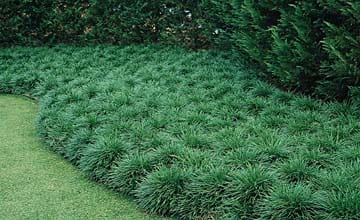Source(s):
- Marjan Kluepfel, HGIC Information Specialist
- Bob Polomski, Extension Consumer Horticulturist, Clemson University
Mondo grass, also known as monkey grass (Ophiopogon japonicus), is an evergreen, sod-forming perennial. The scientific name is derived from ophis = snake, and pogon = beard, most likely referring to the flower spike
Description
Plants are tufted, grasslike and 8 to 16 inches high. The ½-inch leaves are dark green and fine to medium in texture. They are erect to arching, smooth and grasslike. The flowers are usually white or white tinged with lilac. Flowering and fruiting occur from July through September.
Mondo grass is quite often confused with liriope (Liriope muscari). However, the leaves of mondo grass are more narrow than those of liriope, the smaller flowers are hidden by the leaves, the fruits are blue compared to the black fruits of liriope and mondo grass is less cold hardy.
Landscape Use
Mondo grass is primarily used as groundcover. It is also attractive as a border along paths, between stepping stones or flowerbed and lawn, or in rock gardens. It grows well along streams and around garden ponds. Mondo grass competes well with the roots of other plants. Under trees or shrubs it makes an excellent shade-tolerant lawn that never needs mowing.
Cultivation
Mondo grass grows well in ordinary garden soil, requiring minimum attention once established. Plants thrive in filtered sun to full shade and prefer moist soil. The foliage is usually light green when plants are grown in filtered sun. Plants growing in the shade have dark green leaves.
Propagate by dividing large clumps. Be sure to include as many roots as possible and eight to 10 leaves on each section for planting. The plants are easily established and require little effort. The plants do not need heavy feeding. Mondo grass looks attractive year-round. However, the leaves may become ragged by late winter. Shear back the shaggy old leaves in early spring before new growth starts.
Cultivars
- The cultivars ‘Aureovariegatus,’ ‘Variegatus’ and ‘Vittatus’ have longitudinally striped leaves with white or yellow and green stripes. The variable variegated foliage usually makes it difficult to distinguish one cultivar from another.
- The cultivar ‘Caeruleus’ has dark green leaves like the parent species and violet blue flowers.
- ‘Kioto’ or dwarf mondo grass grows only to about 4 inches high. Flowers are small, 2 to 3 millimeters long and light lilac to white.
- ‘Nippon’ is very small (2 to 4 inches tall) and has whitish flowers in the summer.
- ‘Gyoko-ryu’ is even shorter and more compact than ‘Nippon.’
Related Species
- Black mondo grass (Ophiopogon planiscapus) is an interesting introduction from England. The dark purple leaves appear almost black. The plants are about 6 inches tall. In South Carolina, black mondo grass should be planted in partial shade. Cultivars ‘Nigrescens’ and ‘Ebony Knight’ do not differ very much.
- O. jaburan is coarser than O. japonicus, with light purple to white flowers. Plants grow 15 to 18 inches tall but are not as good a groundcover as O. japonicus.
Problems
A fungal disease known as anthracnose is the most common problem. Remove infected leaves and/or apply a recommended fungicide.
Resource(s): Ground Covers
Center Publication Number: 204
